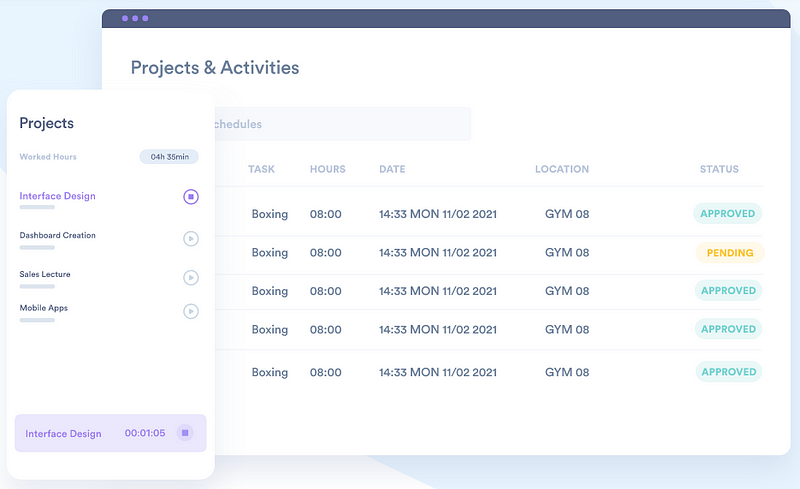Effective project management is the cornerstone of any successful endeavor, no matter its size or complexity. But managing a project can be intimidating when you consider all the variables that could affect its outcome.
One way to ensure success is streamlining your project management process—making it efficient, effective, and more likely to succeed. Here we’ll discuss how you can do just that—from defining goals and objectives to managing resources and everything in between.
By following these steps, you can ensure that your project is completed on time and within budget. Let’s take a closer look at each of these steps so that you can get started on streamlining your project management process today!
Throughout this article, we’ll discuss:
- What Does It Mean To ‘streamline’?
- Process Management Vs Project Management: How Do They Differ?
- Step 1: Define Your Goals And Objectives
- Step 2: Create A Project Plan
- Step 3: Track Your Progress And Milestones
- Step 4: Manage Your Resources
- Step 5: Handle Your Communications
- Step 6: Project Closing
- Automation Ideas for Project Management Process
- Final Thoughts
Whether you’re an experienced project manager or just getting started, these tips will help streamline any project with ease. Let’s get started!

What Does It Mean To ‘streamline’?
Streamlining is the process of making a task or series of tasks more efficient. It can be achieved through automation, but it doesn’t have to be. You can also streamline by optimizing workflows, eliminating unnecessary steps, and improving communication between team members.
Automation is the next big thing for businesses across all industries, and the benefits are truly endless. In sales, for example, automating work processes improves productivity by 14.5% and reduces marketing costs by 12.2%.
So, what is automation? In its simplest form, it is the use of technology to complete tasks that have traditionally been done by people — and it’s just one of the many elements of streamlining.
No matter what type of project you’re managing, streamlining will make the process easier and more efficient. Let’s take a look at some of the best ways to do just that.

Process Management Vs Project Management: How Do They Differ?
Process management and project management are two different things, but they’re closely related. Process management is the practice of managing a series of tasks or activities in order to achieve an end result. It’s about understanding how processes work and making sure that each part operates as efficiently as possible.
Project management, on the other hand, focuses on producing a specific outcome within a given time frame. This means that it needs to consider all aspects of the process—from goal setting to resource allocation—in order to ensure success.
Streamlining your project management process will involve both elements: optimizing existing processes and managing the project itself.
We’ll now explain it with an example. Let’s say you’re managing a project to launch a new product.
The process management part would involve the following tasks:
- Researching and gathering customer feedback
- Developing a product plan and timeline
- Creating detailed product specifications
- Defining the target market and defining pricing
On the other hand, the project management part would involve:
- Defining goals and objectives
- Creating a project plan with milestones
- Tracking progress against the plan
- Managing resources to ensure that tasks are completed on time
- Handling communications between stakeholders.
Role of Process Improvement Project Manager
To ensure the success of the project, it is essential to have a dedicated process improvement project manager. This person needs to be knowledgeable about the project and well-versed in both process management and project management. They should also possess excellent communication skills so that they can effectively coordinate between team members, stakeholders, and other parties involved in the project.
The role of a process improvement project manager is to:
- Define goals and objectives for the process improvement effort
- Develop an action plan with milestones
- Identify areas where improvements need to be made
- Track progress against milestones
- Manage resources and budget
- Communicate regularly with stakeholders
- Identify and address any roadblocks to success.
While project management requires specific approaches and tools, the same is true for process management. Process improvement managers should be familiar with a wide range of tools such as flowcharts, data analysis software, process mapping software, and project planning tools. These can all help to make the streamlining process easier and more efficient.
Now we’ll go over a step-by-step process of how to streamline any project with ease.

Step 1: Define Your Goals And Objectives
In any project that you want to streamline, you need to kick things off with a clear understanding of your goals and objectives. What are you looking to achieve with this project? What is the final outcome that you’re hoping for?
Without this clarity around what you’re doing and why you’re doing it, it’ll be difficult to make any real progress. Not only that, but you’ll encounter many roadblocks along the way if you’re not sure what you’re working towards.
This is why goals and objectives are essential for a streamlined project management process: because without them, you can’t move through your project timeline with the speed and efficiency you require.
To define your goals and objectives, start by asking yourself these questions:
- What are the specific outcomes that I want to achieve? Do I want to improve on one of my previous outcomes? Do I want to reach a certain word count, time limit, or rating?
- What steps do I need to take to get there? Is there a clear path forward that I can turn into a list of straightforward steps?
- What are the deadlines that I need to meet? Are there specific deadlines for different components of the project? Should I be setting additional deadlines to keep my work on track?
- Are there any dependencies or other factors that I need to consider?
Once you have a good understanding of your goals and objectives, you can start outlining the steps that you’ll need to take to achieve them.
CLEAR vs. SMART Goals
Traditionally management professionals have used the SMART Goal setting framework when creating goals for their projects. SMART stands for Specific, Measurable, Achievable, Relevant, and Time-Bound.
However, there is a newer model that has started to gain popularity called the CLEAR goal-setting framework. This acronym stands for Collaborative (team effort), Limited (in scope and duration), Emotional (connecting emotion with outcome), Appreciable (immediate results) and Refinable (evolving as needed).
CLEAR allows greater flexibility and is better suited to projects that involve a lot of collaboration across different departments. In an agile project management process such as Scrum, CLEAR goals provide the focus and direction required for successful outcomes.
In addition, the “collaboration” in CLEAR goal setting encourages team members to work together and become invested in the project. This can lead to greater engagement, productivity and creativity.
Finally, the “emotional” attribute of CLEAR implies that you should be focusing on the feelings associated with achieving a goal. This helps to keep everyone motivated and focused, even when things get tough.
Step 2: Create A Project Plan
When you create a project plan, you are removing all resistance between the project’s concept and its execution. The plan acts as a road map that outlines each step of the project and who is responsible for completing it. This document becomes your Bible for the project; refer to it often to ensure everyone is on track.
Here are the key components of a project plan:
- Project schedule: A timeline that shows when each task will be completed.
- Task list: A detailed list of every task that needs to be done to complete the project.
- Resources: Who will work on the project and what resources (money, equipment, etc.) they will need.
- Budget: How much money will be spent on the project.
- Risk assessment: A list of potential risks and how they will be mitigated.
Not all project plans will help you streamline your process — it depends on how specific you are when creating it. For example, a project timeline with daily tasks is going to be more useful than one with weekly objectives.
Step 3: Track Your Progress And Milestones
Another key step in streamlining your project management process is to track your progress and milestones. Without progress check-ins, you have no way of gauging whether you are on track or not. This can cause delays and even bigger problems down the line; in other words, it completely derails your chances of streamlining your project management process.
To track your progress, there are a number of incredible tools and apps you can use. We are living in the digital age — so make the most of it! Some of our favorites include:
1. Day.io – Overall, the Best Project Tracking Tool for Small Businesses

Day.io is an incredibly helpful project and time tracking tool for small businesses. It helps you set up project timelines and checklists, track progress, assign tasks to team members and more. You can also easily export data from Day.io to your existing accounting software or other applications such as Excel or Google Sheets.
You can also analyze your project profitability and cost details in real-time with Day.io, which makes it easier to stay within your budget. The integrated messaging system also allows you to send messages directly from Day.io, ensuring that your team stays connected and in sync on all fronts.
2. Trello – Excellent Project Management Functionalities with View Cards

Trello is a project management tool that offers an array of features to make tracking projects easier. You can easily create boards for each project and assign tasks to team members as well as track progress. The view cards feature also allows you to keep up with your team’s progress in real-time, making it simple to stay on top of the latest updates.
Trello also offers integrations with other project management and communication tools, such as Slack and Google Drive, so you can easily keep all your project related documents in one place.
3. Asana – Visual Task Management Platform with Support for Agile Project Management

Asana’s exceptional visual task management platform makes it easy to keep track of tasks and projects. You will find drag-and-drop features, easy-to-use project templates, as well as support for the Agile project management process.
Asana is great for tracking tasks and progress on larger projects. On the other hand, if you’re looking to manage smaller projects which require less structure, then Trello might be a better fit.
By tracking your progress, you can ensure that your project management process is running as smoothly as possible. This also allows you to identify any potential delays or problems early on, so that you can address them before they become bigger issues.
Step 4: Manage Your Resources
Nothing screams ‘inefficiency’ more than three people doing a one-person job. It’s also a sign of poor resource management — you can’t expect your team to be productive if you’re not maximizing their potential.
When it comes to resources, think about:
- What tasks are your team members best at? Assign them accordingly. Not everyone is good at everything, so don’t waste time trying to make someone do something they’re not good at.
- What tools and resources are available to help your team be more productive? e.g. Project management software can help automate and streamline tasks, making them easier and faster for your team to complete.
- Are you using the most efficient methods possible? For example, if you’re using a paper-based system to track tasks, are there digital equivalents that can save time and energy?
Maximizing your resources not only makes your team more productive, it also makes them happier. Nobody wants to feel like they’re stuck doing work that’s not their specialty or that could be easily automated.
So, how do you go about managing your resources? Here are a few tips:
- Assess your team and their individual strengths.
- Delegate tasks accordingly and make sure everyone is aware of their role in the project.
- Use tools and resources to help automate and streamline tasks.
- Evaluate the most efficient methods and use those whenever possible.
By managing your resources effectively, you’ll not only make your team more productive, you’ll also save time and energy — both of which are essential for a successful, streamlined project.
Step 5: Handle Your Communications
Our final tip for this article is to properly manage your communications, as without clear and efficient communication, your process of project management rapidly switches from streamlined to messy.
There are a few key ways to manage your communications:
- Use a project management software that includes messaging and commenting features, like Asana or Trello. This will help you keep all your communications in one place, making it easy to track and refer back to.
- Make sure team members are aware of the communication protocols. For example, decide on what channels team members should use to communicate (email, chat app, project management software etc.), and when they should be used.
- Be clear and concise in your communications. When sending a message or commenting in a thread, make sure to state your point clearly and avoid ambiguity. This will help reduce confusion and ensure everyone is on the same page.
- Use templates where possible. If you often send the same types of messages (e.g. meeting requests, status updates, bug reports), create templates for them so that you can quickly draft them without having to type them out every time.
Clear communication is key to a streamlined process of project management because it helps avoid misunderstandings and ensures everyone is on the same page. By following the tips mentioned above, you can easily manage your communications and keep your project running smoothly.
Step 6: Project Closing
The project closing stage is the last part of the project management process. This stage involves collecting feedback from stakeholders, documenting lessons learned and archiving all documents related to the project. In addition, it’s also important to recognize team members for their efforts throughout the duration of the project.
Project success largely depends on how well you close out a project. It’s important to ensure that all goals have been met, that any issues that arose during the course of a project were resolved satisfactorily and that key stakeholders are happy with how everything has gone.
This final step in the streamlining process will help ensure that future projects can benefit from the lessons learned during this one.
Automation Ideas for Project Management Process
Automation is a great way to streamline any project management process. Here are just a few ideas for automating different parts of the project management process:
- Use AI-powered analytics tools to track progress and identify potential issues before they become serious problems;
- Automate time tracking with software like Day.io;
- Utilize advanced AI-powered ChatBots like Google BARD or ChatGPT to provide quick answers to common questions and reduce customer wait times;
- Use automation tools such as Zapier, IFTTT, or Microsoft Flow to automate mundane tasks such as sending emails or updating databases.
Additionally, there are many software platforms available that provide automation features for project management. These include Asana, Trello and Basecamp. All of these tools offer great features to help streamline the process of managing projects and make it easier to stay organized and on track.

Final Thoughts
In the age of AI, streamlining your project management process has never been easier. However, it’s important to have a process in place that works for you and your team; one that makes the most sense for each project. Though daunting, improving your workflow is possible – just use the right tools and follow an appropriate process.
With Day.io’s real-time progress tracking capabilities, you can take control of any project with ease and get it done on time and within budget! Start streamlining your projects now – sign up today!
